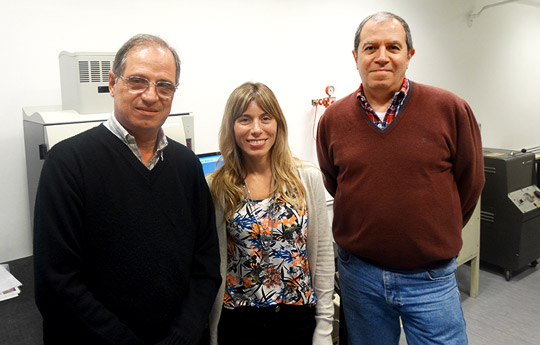IBYME
Towards further understanding of human fertility
CONICET researchers found that the nitric oxide and the histamine modulate the steroid synthesis.
Sex steroid hormones play a vital role in reproduction. In the man, the testosterone – main androgen – is synthesized in the Leydig cells of the testicles. Its function is related to sperm production and the development and maintenance of the male secondary sexual characteristics such as muscles, facial hair and deep voice, among others.
For its part, the hormones of the adrenal gland, mainly the aldosterone and cortisol, are essential for life. While the former one regulates the electrolyte balance of the kidney, the latter is released in response to stress and its main functions associated with the increase of the blood sugar levels, the suppression of the immune system and plays a role in the lipids, proteins and carbohydrates metabolism.
The luteinizing hormone (LH) and the adrenocorticotropic hormone (ACTH) activate the production of androgens and corticoids, respectively. LH and ACTH are produced and released by the pituitary gland located in the brain. Although these are the main stimuli for the production of such steroids, there are other factors that modulate the actions of the LH and ACTH in their target organs, a mechanism known as fine-tune regulation.
The research team lead by Omar Pignataro, principal researcher of CONICET at the Instituto de Biología y Medicina Experimental (IBYME, FYBIME-CONICET) and at the Faculty of Exact and Natural Sciences of the University of Buenos Aires, found that the nitric oxide (NO) and the histamine (HA) also regulate the testicular and the adrenal cortex functions.
The nitric oxide is a small gas molecule that is involved in biological functions such as the vasodilatation, the regulation of normal vascular tone, neuronal transmission and penile erection. Apart from that, Pignataro affirms that “we demonstrated that it directly inhibits the steroid hormone synthesis in Leydig cells, what was later reported by another group when studying the adrenal corticoid synthesis”.
The other molecule that modulates the effects of the LH on the steroidogenesis is the neurotransmitter histamine, which is the main mediator in allergic processes. The studies of the research team, codirected by Pignataro’ and Carolina Mondillo, assistant researcher of CONICET at the IBYME, proved that the concentration of histamine regulates the production of steroids in Leydig cells by activating or suppressing it.
“There is a two-phase effect: at a local level, in the testicles, high concentrations of HA inhibit steroidogenesis. Nevertheless, at low concentrations it promotes and increases the response of the Leydig cells to the LH, what in turn promotes the synthesis of testosterone. We have also found that the inhibitory effect at high concentration is mediated by the production of nitric oxide in the same testicular cells”, Mondillo adds.
The team proposed a mechanism of action in which the HA leads to an increase in the synthesis of NO, which acts on different levels. For instance it reduces the cholesterol transport, from which steroids are obtained, towards the inside part of the mitochondria, therefore inhibiting the testosterone production.
Unlike nitric oxide, Pignataro explains that histamine does not regulate the steroids synthesis in the adrenal glands in the same way that it does in the testicle. “Although it does not promote steroidogenesis, recently we were able to determine that it inhibits the proliferation of human tumor cells in that gland”, Mondillo adds. Besides, she explains that it does not produce cell death but puts the cell cycle into arrest.
Future scenario
Pignataro, Mondillo, their team and researchers of the Hospital Garrahan are currently studying the possibility to use this knowledge to assess a potential therapy for certain types of testicular tumors.
In the case of the adrenal gland, non-surgical treatments for adrenocortical carcinomas are based on ionizing radiation therapies and the administration of cytotoxic substances that should be administered in high doses since their absorption rate is low.
In this respect, the researcher suggests that histamine would exert a cytostatic action on cancer cells. This makes this molecule a good candidate to develop combined therapies to reduce the drug doses or radiations. This will in turn enable to minimize the adverse effects of the treatment, as it has been reported in human colon carcinoma cell with the combined use of an antihistamine and ionizing radiations.
- By Cecilia Leone
